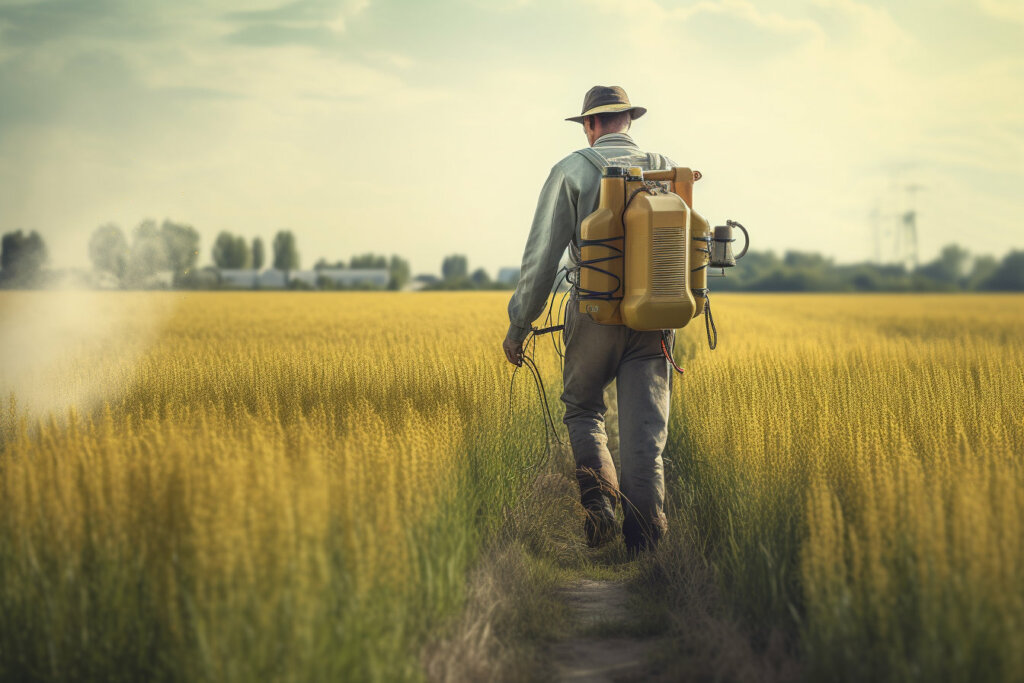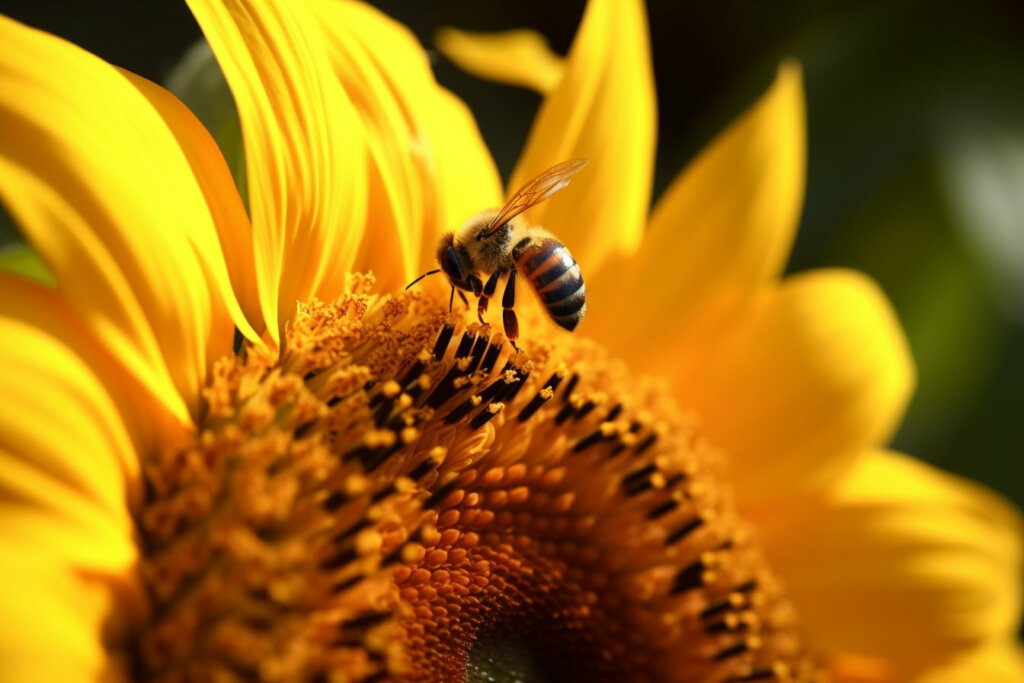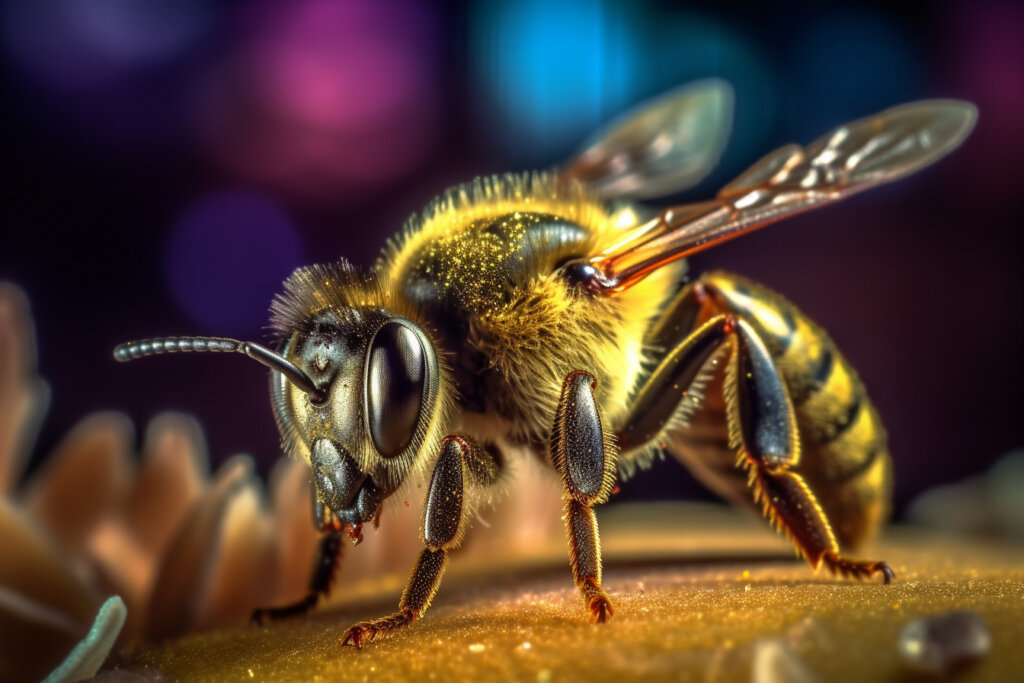Background on Honey Bees
Honey bees (Apis mellifera) are among the most recognized and celebrated insects due to their pivotal role in pollination and honey production. Originating from Asia, they have spread globally, adapting to diverse environments and climates. Their colonies are highly organized, consisting of a single queen, a few hundred drones (males), and thousands of worker bees (sterile females).
Importance of Honey Bees for Ecosystems and Agriculture
Honey bees play a crucial role in ecosystems and agriculture, mainly through their work as pollinators. They transfer pollen from male to female flower parts, enabling fertilization and the production of fruits and seeds. This process is vital for the reproduction of many plants, including crops. In fact, it’s estimated that nearly one-third of the food that we consume each day relies on pollination mainly by bees. Their contribution to agriculture is not only limited to food production; they also play a role in producing honey, beeswax, royal jelly, and propolis – all commodities with significant economic value.
Brief Overview of Honey Bee’s Conservation Status
Over the past few decades, there has been growing concern about the decline in honey bee populations. Factors such as habitat loss, climate change, pesticides, diseases, and parasites have been linked to this decline. Despite these alarming trends, the conservation status of honey bees is complex and varies depending on the region. This guide aims to provide a comprehensive overview of the current status of honey bees, the threats they face, and the steps being taken towards their conservation.
Understanding the Honey Bee Population
Species and Distribution of Honey Bees Globally
The term ‘honey bee’ actually refers to a number of species within the genus Apis, the most common of which is the Western honey bee (Apis mellifera). There are also Eastern honey bees (Apis cerana), Dwarf honey bees (Apis florea and Apis andreniformis), Giant honey bees (Apis dorsata and Apis laboriosa), and the Koschevnikov’s honey bee (Apis koschevnikovi) among others. Each species has its own unique geographical range, though the Western honey bee is widely distributed across the globe due to human domestication and beekeeping practices.
The Role of Honey Bees in Pollination and Food Production
Honey bees are integral to pollination, which is crucial for the propagation of many plants. They visit flowers to collect nectar and pollen, and in the process, pollen grains stick to their bodies. When they visit the next flower, some of this pollen is transferred, resulting in fertilization. This pollination process is essential for the fruiting of many agricultural crops, including almonds, apples, cherries, and blueberries, among others.
In addition to pollination, honey bees also produce honey by converting nectar into a sweet, viscous liquid. This honey, along with other products like beeswax and royal jelly, is harvested and used in a variety of food, health, and cosmetic products.
Current Population Trends of Honey Bees
While honey bee populations have shown resilience and adaptability, there are concerning trends of decline in many parts of the world. Colony Collapse Disorder, where the majority of worker bees in a colony disappear, is a particular concern in North America and Europe. Other threats, such as habitat loss, climate change, pesticides, and diseases, are also causing significant challenges to honey bee populations globally. The exact numbers and rates of decline are difficult to quantify due to varying data collection methods and regional differences, but the overall trend raises serious concerns about the long-term survival of honey bees.
Threats to Honey Bee Survival

Impact of Pesticides on Honey Bees
Pesticides pose one of the most significant threats to honey bees. These chemicals, often used in agriculture to control pests, can have lethal and sub-lethal effects on bees. Exposure to pesticides can lead to immediate death or can affect their behavior and physiological functions, impacting their foraging ability, learning and memory, and resistance to disease. Neonicotinoids, a class of insecticides, have been particularly associated with harming honey bees and other pollinators.
Effects of Climate Change and Habitat Loss
Climate change and habitat loss are also significant threats to honey bees. Changes in temperature and precipitation patterns can disrupt the availability and diversity of nectar and pollen resources, affecting bee nutrition and health. Habitat loss due to urbanization, intensive agriculture, and deforestation leads to the reduction of floral resources and nesting sites, further threatening bee populations.
The Issue of Colony Collapse Disorder
Colony Collapse Disorder (CCD) is a phenomenon where the majority of worker bees in a colony disappear, leaving behind a queen, food, and a few nurse bees to care for the remaining immature bees. The exact cause of CCD is unknown, but it is believed to be a result of a combination of stressors including pesticides, diseases, poor nutrition, and bee management practices. CCD has been a significant factor in the decline of honey bee colonies, particularly in North America and Europe.
Presence of Predators and Diseases
Honey bees face threats from various predators, parasites, and diseases. The Varroa mite is a significant parasite that infests honey bee colonies, weakening bees and transmitting viruses. Diseases such as American foulbrood, Nosema infections, and viral diseases can also have devastating effects on colonies. In addition, honey bees have natural predators such as bears, birds, and other insects. These threats, combined with other environmental and anthropogenic stressors, can lead to the decline and potential endangerment of honey bee populations.
Are Honey Bees Endangered?

Analyzing the Status of Honey Bees on Endangered Species Lists
As of 2023, there are several species of bees listed as endangered under the Endangered Species Act of 1973. However, the common honey bee (Apis mellifera) is not currently listed as endangered. In 2017, the rusty-patched bumblebee became the first bumblebee species to be listed as endangered. Similarly, seven varieties of Hawaiian yellow-faced bees were listed as endangered in 2016. The American bumblebee is also being petitioned for consideration as an endangered species due to a significant decline in its population.
Scientific Studies and Opinions on Honey Bee Endangerment
Scientific studies have revealed that honey bees are indeed under threat. Factors including habitat loss, pesticides, climate change, diseases, and poor bee management practices are causing declines in their populations. Honeybees are responsible for about 80% of the world’s pollination, and they are dying at high rates. The loss of bees and the plants they pollinate would have far-reaching impacts on ecosystems and our food supply. Certain fruits and vegetables that rely on bee pollination might become less available, and several ecosystems that depend on these plants would be significantly affected.
Case Studies: Honey Bee Populations in Specific Regions
When examining honey bee populations in specific regions, it becomes clear that the situation can vary widely. For instance, in North America, honey bees have been severely affected by Colony Collapse Disorder, where most worker bees in a colony disappear, leading to the collapse of the colony. On the other hand, in some parts of the world, honey bees are still abundant but face threats from habitat loss and pesticide exposure.
While honey bees as a whole are not currently classified as endangered, they face significant threats that could potentially lead to their endangerment in the future. This status, however, does not diminish the urgency of the situation. The decline of honey bees and other pollinators poses severe risks to global food security, biodiversity, and ecosystem health, making their conservation a high priority.
The Future of Honey Bees: Predictions and Projections
Predicted Impacts of Current Trends on Honey Bee Populations
If current trends continue, the impacts on honey bee populations could be dire. Pesticides, climate change, habitat loss, diseases, and poor bee management practices all pose significant threats. Colony Collapse Disorder, in particular, could lead to widespread declines in honey bee populations, especially in regions where it’s already a problem.
The effect of climate change on bees is also of great concern. Changing weather patterns may disrupt the availability and diversity of nectar and pollen resources, thereby affecting bee nutrition and health. Extreme weather events, increased temperatures, and shifts in plant blooming times could all negatively impact bees. Furthermore, habitat loss due to urbanization, deforestation, and changes in land use will likely continue to be a major challenge for honey bees.
Role of Honey Bees in Future Food Security
Honey bees play a critical role in global food security, as they are responsible for the pollination of many agricultural crops. If their populations continue to decline, the production of the fruits, vegetables, and nuts that rely on these pollinators would be severely affected. This could lead to decreased availability and increased prices for these foods, impacting both the economy and human nutrition.
Furthermore, honey bees contribute to the production of honey, beeswax, royal jelly, and propolis, which have significant economic value. A decline in honey bee populations could therefore also affect these industries.
Potential Consequences of Honey Bee Endangerment for Biodiversity
Bees are key biodiversity promoters due to their role in plant pollination. They help to maintain the health and diversity of ecosystems by aiding in the reproduction of a wide range of plant species, many of which provide habitats and food for other wildlife.
A decline in bee populations could therefore have cascading effects on biodiversity. The loss of plant species that rely on bees for pollination could lead to declines in the populations of other species that depend on these plants for food and habitat. This could potentially lead to a decrease in biodiversity and disrupt ecosystem functioning.
In conclusion, honey bees play a crucial role in our ecosystems and food production. The threats they face and their potential decline could have significant impacts on global food security and biodiversity. It’s therefore vital that efforts are made to protect and conserve honey bee populations for the future.
Steps Towards Honey Bee Conservation

Efforts by Governments and Conservation Organizations
Governments and conservation organizations worldwide are implementing various measures to protect and conserve honey bees. These include policies to reduce the use of harmful pesticides, initiatives to restore and protect natural habitats, and programs to raise awareness about the importance of bees. Some countries have also enacted legislation specifically aimed at protecting pollinators, such as the Pollinator Health Task Force in the United States.
Conservation organizations, such as the Xerces Society and Pollinator Partnership, are conducting research, providing educational resources, and advocating for policies that benefit pollinators. These groups are instrumental in highlighting the importance of pollinators and promoting practices that support their survival.
Role of Beekeeping in Honey Bee Conservation
Beekeeping plays a crucial role in honey bee conservation. Responsible beekeeping practices can help maintain healthy bee populations and contribute to pollination. Beekeepers can also serve as advocates for bees, educating the public about their importance and the threats they face.
However, it’s important to note that not all beekeeping practices are beneficial for bees. Practices such as the use of chemical treatments and the transportation of bees for commercial pollination can be harmful. Therefore, promoting sustainable and ethical beekeeping practices is essential for honey bee conservation.
Best Practices for Individuals to Protect Honey Bees
Individuals can contribute significantly to honey bee conservation. Planting a variety of native, flowering plants can provide valuable food resources for bees. Avoiding or minimizing the use of pesticides in gardens and landscapes can also help protect bees.
Supporting local beekeepers by purchasing local honey and other bee products can contribute to the viability of sustainable beekeeping practices. Advocacy and education are also important – individuals can help spread awareness about the importance of bees and the steps we can take to protect them.
Innovative Solutions for Honey Bee Conservation
Innovative solutions are also being explored for honey bee conservation. For example, researchers are developing new bee-friendly pesticides and studying the use of other insects for pollination as a supplement to bees. Technology is also being used to monitor bee health and track population trends. These innovative solutions, combined with traditional conservation methods, can offer hope for the future of honey bees.
Conclusion
Recap of Honey Bee Endangerment Status
While honey bees as a whole are not currently classified as endangered, they face significant threats that could potentially lead to their endangerment in the future. Factors such as habitat loss, pesticides, diseases, and climate change are contributing to declines in honey bee populations.
The Urgency of Protecting Honey Bees
The importance of honey bees to our ecosystems and food systems cannot be overstated. They play a critical role in pollinating many of the plants that make up the world’s food supply, and their decline could have far-reaching impacts on global food security and biodiversity. The conservation of honey bees is therefore not just a matter of environmental concern, but also of human survival.
Final Thoughts on the Future of Honey Bees and Our Role in their Survival
The future of honey bees largely depends on the actions we take now. From governments and conservation organizations to individual citizens, everyone has a role to play in protecting and conserving honey bees. By implementing sustainable practices, advocating for policies that protect bees, and raising awareness about their importance, we can help ensure the survival of honey bees and, in turn, our own.
